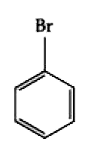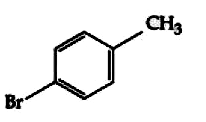A
(iii) 4-Bromophenyl acetic acid.
In the above reaction 'A' is




The correct Answer is:C
To determine the reactant 'A' that leads to the formation of 4-Bromophenylacetic acid through the given reactions, we can break down the steps as follows:
1. Identify the Final Product:
The final product is 4-Bromophenylacetic acid. This compound has a bromine atom at the para position (4-position) of the phenyl ring and an acetic acid functional group.
2. Analyze the Reagents:
The reagents provided are:
- Cl₂ (chlorine gas) with heat
- CN⁻ (cyanide ion)
- H₂O/H⁺ (acidic hydrolysis)
3. Determine the Starting Material:
To obtain 4-Bromophenylacetic acid, we need to consider the first step involving chlorination. The presence of bromine in the final product suggests that we need a compound that can undergo chlorination to introduce a chlorine atom at the para position.
4. Propose the Initial Compound:
A suitable starting compound that contains a bromine atom and can undergo chlorination is 4-Bromotoluene (p-bromotoluene). The structure of 4-Bromotoluene is:
- A benzene ring with a bromine atom at the para position and a methyl group (–CH₃) at the ortho position.
5. First Reaction - Chlorination:
When 4-Bromotoluene is treated with Cl₂ in the presence of heat, the methyl group can be chlorinated to form 4-Bromo-1-chlorotoluene. The chlorine atom will replace one of the hydrogen atoms on the methyl group.
6. Second Reaction - Nucleophilic Substitution:
The next step involves the reaction with CN⁻. The cyanide ion will perform a nucleophilic substitution reaction, replacing the bromine atom at the para position to form 4-Cyanotoluene.
7. Final Reaction - Hydrolysis:
Finally, when 4-Cyanotoluene is treated with H₂O in the presence of acid (H⁺), hydrolysis occurs, converting the nitrile group (–C≡N) into a carboxylic acid group (–COOH), resulting in the formation of 4-Bromophenylacetic acid.
Conclusion:
Thus, the reactant 'A' is 4-Bromotoluene.
The final product is 4-Bromophenylacetic acid. This compound has a bromine atom at the para position (4-position) of the phenyl ring and an acetic acid functional group.
The reagents provided are:
- Cl₂ (chlorine gas) with heat
- CN⁻ (cyanide ion)
- H₂O/H⁺ (acidic hydrolysis)
To obtain 4-Bromophenylacetic acid, we need to consider the first step involving chlorination. The presence of bromine in the final product suggests that we need a compound that can undergo chlorination to introduce a chlorine atom at the para position.
A suitable starting compound that contains a bromine atom and can undergo chlorination is 4-Bromotoluene (p-bromotoluene). The structure of 4-Bromotoluene is:
- A benzene ring with a bromine atom at the para position and a methyl group (–CH₃) at the ortho position.
When 4-Bromotoluene is treated with Cl₂ in the presence of heat, the methyl group can be chlorinated to form 4-Bromo-1-chlorotoluene. The chlorine atom will replace one of the hydrogen atoms on the methyl group.
The next step involves the reaction with CN⁻. The cyanide ion will perform a nucleophilic substitution reaction, replacing the bromine atom at the para position to form 4-Cyanotoluene.
Finally, when 4-Cyanotoluene is treated with H₂O in the presence of acid (H⁺), hydrolysis occurs, converting the nitrile group (–C≡N) into a carboxylic acid group (–COOH), resulting in the formation of 4-Bromophenylacetic acid.
Thus, the reactant 'A' is 4-Bromotoluene.
Similar Questions
Knowledge Check

(1)Cl2/hv−−−−−−→(2).HOΔ product isA B
B C
C D
D
Consider the following reaction,
AK2Cr2O7−−−−−−−→H2SO4AcetoneOxidation−−−−−→Acetic acid Identify A in the above reaction.A1-propanolB2-propanolC2-butanolDEthanolNH4Cl+NaNO2Δ−−→N2↑⏐⏐+NaCl+H2O
AFor disproportionation reaction.BFor comproportionation reaction.CFor either intermolecular redox reaction or displacement reactionDFor either thermal combination redox reaction or thermal decomposition redox reaction.
CH3CO2C2H5(i)C2H5¯¯¯O+Na/Δ−−−−−−−−−−→(ii)H3O+
The structure of the compound A is
View SolutionCl2NaOH−−−→NaCl+NaClO3+H2O
The equivalent mass of Cl2 in the above reaction is
View SolutionPhenol NaNO2/H2SO4−−−−−−−−−→BH2O−−→CNaOH−−−→D
Name of the above reaction is
View Solution
(i)LiAIH4−−−−−−→(ii)H2O(A)
Product (A) of above reaction is :
View SolutionIn the sequence of reaction .
CH3−CH2−CH=CH2(i)B2H6/THF−−−−−−−−−−→(ii)H2O2/NaOHAconc.H2SO4−−−−−−→BH3O+−−−→C
In above reaction A and C are respectively
View Solution
